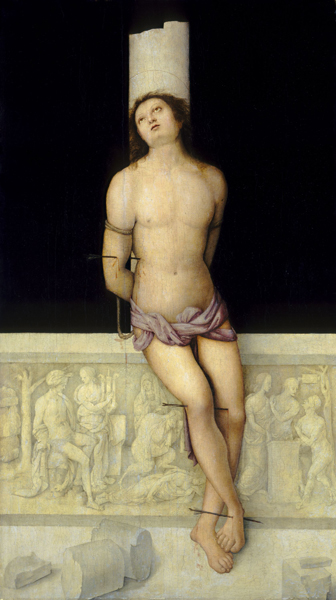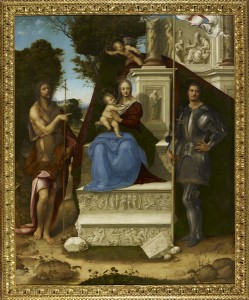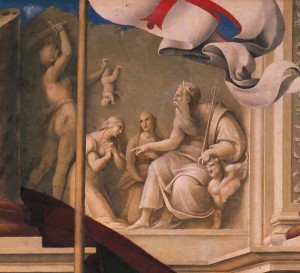
Amico Aspertini
Saint Sebastian, c. 1505
Oil on panel, 114.9 x 66 cm (45 1/4 x 26 in.)
National Gallery of Art, Washington, DC, Samuel H. Kress Collection
Image courtesy of the Board of Trustees, National Gallery of Art

Cesare da Sesto (Il Milanese)
The Madonna and Child with Saint John the Baptist and Saint George, c. 1514
Oil on panel transferred to pressed wood, 254.6 x 205.7 cm (100 1/4 x 81 in.)
Fine Arts Museums of San Francisco, Gift of the Samuel H. Kress Foundation
The compelling illusionism of Gian Francesco’s Saint Sebastian showcased the artist’s technical skill—specifically, his ability to simulate the three-dimensional appearance of relief carving and the varied coloration and veining of different types of marble. In another depiction of the Saint Sebastian theme, Amico Aspertini invited comparisons between the nude saint and the figures represented in the simulated bas-relief behind him. The juxtaposition of human and sculptural bodies calls attention to their similarities (as exemplars of classically idealized forms) and their differences (as pliant flesh on the one hand and hard, polished marble on the other). Shown with eye-deceiving realism, these contrasting materials highlight Aspertini’s technical virtuosity.
The hyper-realistic style that painters brought to the representation of sculpture showcased the same skill in emulating nature that Renaissance collectors revered in classical antiquities. Though often made of precious gemstones and medals, these ancient artifacts were truly priceless (as it was fashionable to say) for their peerless craftsmanship, which seemed more divine than human. (Read A collector enjoys his treasures.) In subscribing to this view, Renaissance artists and collectors may have been influenced by the praise bestowed on the quality of mimesis in antique commentary on painting. An anecdote made famous by the Roman writer Pliny the Elder told of a competition in which the Greek painter Zeuxis depicted a bunch of grapes so convincingly that he deceived a flock of hungry birds, only to be fooled himself by the trompe l’oeil curtain painted by his rival Parrhasius. Because so few specimens of ancient paintings were known during the Renaissance, hints by authors such as Pliny supplemented the evidence of ancient sculpture in providing ideas of what Greek and Roman painting may have looked like.

Cesare da Sesto (Il Milanese)
The Madonna and Child with Saint John the Baptist and Saint George (detail of the Judgment of Solomon), c. 1514
Oil on panel (transferred to pressed wood), 254.6 x 205.7 cm (100 1/4 x 81 in.)
Fine Arts Museums of San Francisco, Gift of the Samuel H. Kress Foundation
But the illusionistic representation of sculpture in painting was more than just a demonstration of artistic skill. In Aspertini’s painting, the vividly rendered sculptural elements also reinforce the theme of martyrdom. The fragments on the ground and the broken column to which Saint Sebastian is bound (which rises from his shoulders almost as an extension of his head and neck) offer metaphors for the saint’s broken body and for the ephemeral nature of all earthly things. The bas-relief—emblematic of outmoded civilizations and faiths—reinforces the theme of obsolescence and decay. Gazing heavenward, Saint Sebastian places his faith in the eternal truth of Christ.
The imagery of the bas-relief itself accentuates the painting’s somber mood. To the left of the saint’s pierced leg, a veiled woman and a satyr are grieving over the lifeless body of a young girl. The exact subject matter and its connotations for the picture are now obscure, and they may not have been much clearer to the artist and his patron. The mysteries of pagan ritual fascinated Aspertini, and he may have intended the arcane sculptural scene to contribute to the painting’s atmosphere rather than to its meaning. The relief also exemplifies the inventiveness of Renaissance adaptations of ancient sources. The image of the mourning satyr bent over a dead body derives from a Roman sculpture Aspertini had studied and modified to suit his own fancy. When drawing the sculpture in his sketchbook, he spontaneously substituted a young woman for the decapitated ram in the original sculpture. Whereas an archaeologist or antiquarian would document the exact appearance of such an object, Aspertini—as did many of his contemporaries—treated drawings as opportunities to imaginatively reconfigure antique source material for new creative purposes.

Cesare da Sesto (Il Milanese)
The Madonna and Child with Saint John the Baptist and Saint George (detail of throne steps), c. 1514
Oil on panel (transferred to pressed wood), 254.6 x 205.7 cm (100 1/4 x 81 in.)
Fine Arts Museums of San Francisco, Gift of the Samuel H. Kress Foundation
The Milanese painter Cesare da Sesto made similarly imaginative use of a personal collection of drawings after the antique, many executed during a visit to Rome in 1508. The Madonna and Child with Saint John the Baptist and Saint George, c. 1514, features an ambitious assemblage of pseudo-antique reliefs that subtly inflect the meaning of the painting. Tucked into the upper right corner is a representation of the Judgment of Solomon in which a kneeling woman pleads for the life of the child held aloft by his would-be executioner. By relinquishing all claims to the baby on the condition that his life be spared, the woman convinced Solomon that she, and not her jealous rival, was actually the child’s mother. This imbedded narrative reinforces a subtext of Cesare’s painting, drawing attention to the Virgin’s love for Jesus, the child she will one day give up to save the souls of others.
The Virgin’s throne rests on steps ornamented with a variety of purely decorative motifs (such as putti riding gryphons and dolphins) and a central scene of the sun god Apollo with the nine muses on Mount Parnassus. Both Solomon and Apollo were associated with judgment, wisdom, civilization, and virtue, and were therefore identified by Renaissance theologians as precursors of Christ. In Cesare’s painting, we see the fulfillment of their promise, with Christ and his mother seated in triumph on the ruins of pagan civilization.
The most ambitious and archaeologically sophisticated representations of sculpture in painting were produced by Mantegna. Celebrated for his ability to imitate marble and other materials, Mantegna began a series of Roman subjects in the 1490s in which he masterfully simulated ancient bas-reliefs. He carried out these imitation sculptures in monochrome tones of gray (a form of painting known as grisaille), often setting them against contrasting backdrops painted to look like colored marble. In 1505 a wealthy Venetian, Francesco Cornaro (1476–1543), commissioned Mantegna to produce a cycle of scenes from Roman history for a room in his family palace. Cornaro traced his ancestry to the Cornelius family of Rome, lauded in 1504 by the humanist Hieronimo Avanzi as “ancient and noble above all the other families of Europe and…rich in splendid deeds performed in every age.”4 In tribute to these illustrious forbears, Mantegna designed a frieze composed of four illusionistic paintings, each highlighting the virtuous conduct of a member of the Cornelius family.

Giovanni Bellini
An Episode from the Life of Publius Cornelius Scipio, after 1506
Oil on canvas, 74.8 x 356.2 cm (29 7/16 x 140 1/4 in.)
National Gallery of Art, Washington, DC, Samuel H. Kress Collection
Image courtesy of the Board of Trustees, National Gallery of Art
Mantegna died in 1506, having completed only one of the paintings, but he had prepared canvases for the other three. One of these, An Episode from the Life of Publius Cornelius Scipio, after 1506, was painted by Giovanni Bellini, who was compelled by the unusual circumstances to apply his brother-in-law’s hard-edged, sculptural style. Bellini’s painting represents the great Roman general Publius Cornelius Scipio Africanus (236–183 BC)—the most famous member of his family—receiving a procession of captives and war booty following his victory over the Carthaginians in 206 BC. As his troops look on, Scipio demonstrates the virtues of charity and self-restraint by giving up a beautiful female hostage whom he returns to her fiancé along with the dowry that her parents had offered as ransom. Within a frame modeled on a first-century Roman candelabrum base, a Latin inscription compares the marshaling of desire with the marshaling of troops: TVRPIVS IMPER(ARI) VENERE Q(VAM) ARMIS VINCI (“It is more shameful to be governed by Venus than to be conquered by arms”).
Close study of ancient models enabled Mantegna and Bellini to imitate convincingly both the pictorial motifs and the physical materials of classical relief sculpture. While Scipio’s sphinx throne and the relief carvings on its stepped platform convey the impression of archaeological authenticity, they are artistic inventions. Placed end-to-end high up on a wall, the paintings in the Cornaro series might have been mistaken for an actual architectural frieze, but they were all the more valuable for the mimetic skill with which the two-dimensional painted surface was made to resemble a three-dimensional marble relief.